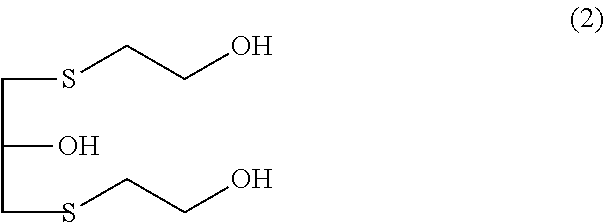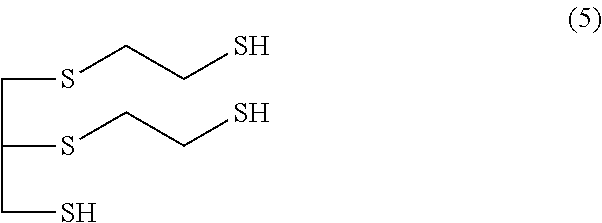Method for producing polythiol compound, polymerizable composition for optical material, and uses thereof
a technology of polythiol compound and composition, which is applied in the direction of optical elements, instruments, organic chemistry, etc., can solve the problems of large quantity of defective polythiol compounds, color, transparency and optical homogeneity of plastic lenses, and difficulty in evaluating the quality of polythiol compounds as monomers, etc., to achieve the effect of improving quality
- Summary
- Abstract
- Description
- Claims
- Application Information
AI Technical Summary
Benefits of technology
Problems solved by technology
Method used
Image
Examples
examples
[0124]Hereinafter, the present invention will be described in more detail based on Examples, however the invention is not intended to be limited to these.
[0125]In the following Examples, properties were measured by the following measurement methods.[0126]APHA: This is a method for indicating the color, and the color was determined using standard liquids prepared by dissolving reagents of platinum and cobalt, and determining a standard liquid dilution having a color density equivalent to that of the color of the sample by making a comparison. Thus, the “degree” of the color was defined as the measured value.[0127]Water content: A sample was dissolved in toluene, and water measurement was carried out using a Karl-Fischer Water Titrate.[0128]Viscosity: The viscosity was measured according to JIS K7117.[0129]Refractive index: The refractive index was measured at 20° C. using a digital refractometer, RA-600, manufactured by Kyoto Electronics Manufacturing Co., Ltd.[0130]Ammonium content:...
example a-1
Synthesis of Polythiol Compound Containing 4-mercaptomethyl-1,8-dimercapto-3,6-dithiaoctane as Main Component
[0136]In a reactor, 124.6 parts by weight of 2-mercaptoethanol and 18.3 parts by weight of degassed water (dissolved oxygen concentration: 2 ppm) were introduced. 101.5 parts by weight of a 32 wt % aqueous solution of sodium hydroxide was added dropwise thereto over 40 minutes at 12° C. to 35° C., and then 73.6 parts by weight of epichlorohydrin was added dropwise thereto over 4.5 hours at 29° C. to 36° C. Subsequently, the mixture was stirred for 40 minutes. Production of 1,3-bis(2-hydroxyethylthio)-2-propanol was confirmed from NMR data.
[0137]331.5 parts by weight of 35.5% hydrochloric acid was introduced, and then 183.8 parts by weight of thiourea having a purity of 99.90% was introduced. The mixture was stirred for 3 hours under reflux at 110° C., and thereby a reaction which forms thiuronium salt was carried out. The reaction mixture was cooled to 45° C., and then 320.5 ...
examples a-2
to A-10
[0147]Polythiol compounds containing 4-mercaptomethyl-1,8-dimercapto-3,6-dithiaoctane as a main component were respectively produced in the same manner as in Example A-1, except that the production conditions described in Table-1 were used. The properties of the polythiol compounds thus obtained are shown in Table-1. Furthermore, the viscosities after 7 hours of the polymerizable compositions were measured, and plastic lenses were produced, in the same manner as in Example A-1. The results are shown in Table-2.
PUM
| Property | Measurement | Unit |
|---|---|---|
| temperature | aaaaa | aaaaa |
| temperature | aaaaa | aaaaa |
| temperature | aaaaa | aaaaa |
Abstract
Description
Claims
Application Information
 Login to View More
Login to View More - R&D
- Intellectual Property
- Life Sciences
- Materials
- Tech Scout
- Unparalleled Data Quality
- Higher Quality Content
- 60% Fewer Hallucinations
Browse by: Latest US Patents, China's latest patents, Technical Efficacy Thesaurus, Application Domain, Technology Topic, Popular Technical Reports.
© 2025 PatSnap. All rights reserved.Legal|Privacy policy|Modern Slavery Act Transparency Statement|Sitemap|About US| Contact US: help@patsnap.com



